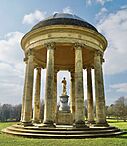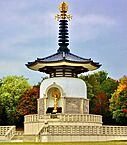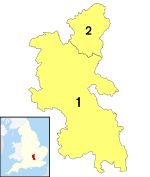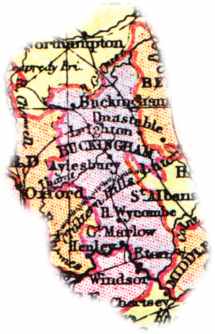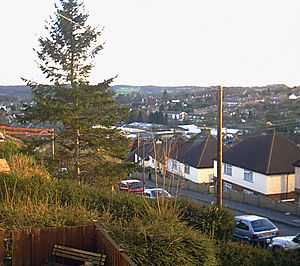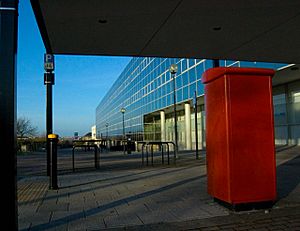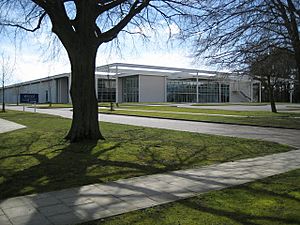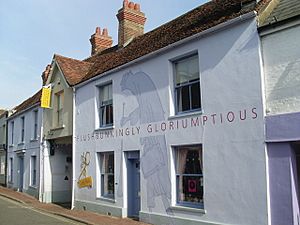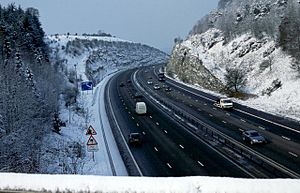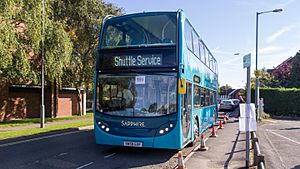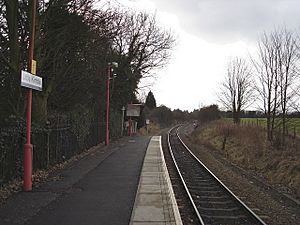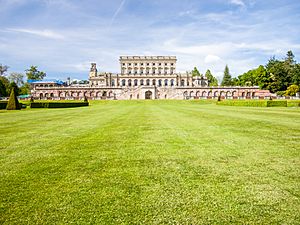Buckinghamshire facts for kids
Quick facts for kids
Buckinghamshire
|
|||||||||||||||||||||||||||||||||
|---|---|---|---|---|---|---|---|---|---|---|---|---|---|---|---|---|---|---|---|---|---|---|---|---|---|---|---|---|---|---|---|---|---|
|
The Chiltern Hills, the Rotunda in Stowe Gardens (bottom left), and the Peace Pagoda in Milton Keynes (bottom right)
|
|||||||||||||||||||||||||||||||||
 |
|||||||||||||||||||||||||||||||||
| Sovereign state | United Kingdom | ||||||||||||||||||||||||||||||||
| Constituent country | England | ||||||||||||||||||||||||||||||||
| Region | South East | ||||||||||||||||||||||||||||||||
| Established | Ancient | ||||||||||||||||||||||||||||||||
| Time zone | UTC±00:00 (Greenwich Mean Time) | ||||||||||||||||||||||||||||||||
| • Summer (DST) | UTC+01:00 (British Summer Time) | ||||||||||||||||||||||||||||||||
| Members of Parliament | 7 MPs | ||||||||||||||||||||||||||||||||
| Police | Thames Valley Police | ||||||||||||||||||||||||||||||||
| Largest city | Milton Keynes | ||||||||||||||||||||||||||||||||
|
|||||||||||||||||||||||||||||||||
Buckinghamshire, often called Bucks, is a county in South East England. It is one of the home counties, which are areas close to London. Buckinghamshire shares borders with Northamptonshire, Bedfordshire, Hertfordshire, Greater London, Berkshire, and Oxfordshire.
The biggest city in Buckinghamshire is Milton Keynes. The county town, which is like its main administrative center, is Aylesbury. The county covers about 1,874 square kilometers (723 square miles). In 2021, about 840,138 people lived here.
A beautiful area called the Chiltern Hills is in the south of the county. This area is known for its natural beauty. The River Thames also forms part of the county's southern border. Buckinghamshire is home to Pinewood Film Studios and part of the Silverstone Circuit race track. Many companies also have offices in Milton Keynes.
Contents
History of Buckinghamshire
The name Buckinghamshire comes from Anglo-Saxon times. It means "The district (scire) of Bucca's home." Bucca was an Anglo-Saxon landowner, and his home was in Buckingham. The county has been called this since around the 12th century. However, the area has been a county since the kingdom of Mercia existed.
The history of Buckinghamshire goes back even further, to the Brittonic and Roman times. But the Anglo-Saxons had the biggest impact on the county's look and feel. Later, Buckinghamshire became important in politics. For example, King Henry VIII was involved in local matters in the 1500s. A century later, the English Civil War is said to have started in mid-Bucks because of John Hampden.
A big change happened in the 1800s. Many people moved away from the countryside to find work in towns. This made land cheaper, and rich people started buying it. Buckinghamshire became a popular place for a peaceful country life. This image still holds true today. Many people who work in London live here, making the area quite wealthy.
Because London grew and railways were built, towns like Aylesbury, Amersham, and High Wycombe in the south of the county became much larger. The town of Buckingham, in the north, became less central. Now, most important county offices are in the south or in Milton Keynes.
Geography and Nature
Buckinghamshire has two main geographical parts. In the south, the land rises gently from the River Thames to the Chiltern Hills. On the northern side of the Chilterns, the land drops more steeply. This leads to the Vale of Aylesbury and the City of Milton Keynes, which are flatter areas.
Rivers and Canals
Rivers
The county has parts of two of England's longest rivers. The River Thames forms the southern border with Berkshire. The River Great Ouse starts just outside the county. It flows east through Buckingham, Milton Keynes, and Olney.
Canals
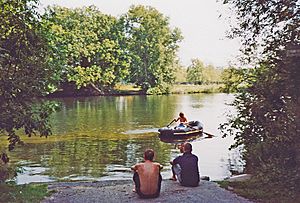
The main part of the Grand Union Canal goes through Buckinghamshire. It also has branches that go to Slough and Aylesbury. Some older parts of the canal are no longer used. The canal has even been included in the design of Milton Keynes.
Landscape Features
The southern part of the county is mostly covered by the Chiltern Hills. The two highest points in Buckinghamshire are Haddington Hill (267 meters or 876 feet high) and Coombe Hill (260 meters or 853 feet high).
Quarrying
People have dug up chalk, clay (for making bricks), gravel, and sand in the river valleys. Flint, also dug from quarries, was used to build many old local buildings. Some old quarries are now filled with water and have become nature reserves.
Population and Communities
| Authority | Main towns | Population (2011) |
Area (km2) |
Population density (2011) |
Projected population (2026) |
|---|---|---|---|---|---|
| Buckinghamshire Council | Aylesbury, Buckingham, High Wycombe, Marlow, Amersham, Chesham, Beaconsfield, Burnham | 505,283 | 1564.95 | 323/km2 | 530,800 |
| Milton Keynes City Council | Milton Keynes urban area (includes towns of Bletchley, Central Milton Keynes, Fenny Stratford, Newport Pagnell, Stony Stratford, Woburn Sands and Wolverton), Olney | 248,821 | 308.63 | 806/km2 | 323,146 |
| Total for ceremonial county | 754,104 | 1873.58 | 402/km2 | 853,946 | |
Buckinghamshire is a diverse place today, especially in its larger towns. In the late 1800s, some Welsh families settled in the north. In the late 1900s, many Londoners moved to Milton Keynes.
Aylesbury has a notable Asian community. Chesham also has a similar-sized Asian community. High Wycombe is the most diverse town, with large Asian and Afro-Caribbean populations. During World War II, many Polish, Czech, and Albanian people settled here. Some of their families still live in the county.
Economy and Industry
Buckinghamshire has a modern economy based on services. It is one of the richest subregions in the European Union. The county has a high quality of life and excellent education results. The southern part of the county is a wealthy area where many people commute to London for work.
The county has good farming land. Many large estates, especially those owned by the Rothschild banking family of England in the 1800s, are here. Buckinghamshire hosts several annual agricultural shows, like the Bucks County Show, which started in 1859.
Manufacturing industries include furniture-making, which is traditionally centered in High Wycombe. Other industries are pharmaceuticals and food processing. Pinewood Studios in Iver Heath is a major center for film and TV production in the UK.
Places to Visit
Buckinghamshire is famous for its open countryside and natural beauty. This includes the Chiltern Hills and Stowe Landscaped Gardens near Buckingham. The River Thames is also a key feature. The Ridgeway Path, a long walking trail, goes through the county.
The county also has many historic houses. Some are open to the public through the National Trust. These include Waddesdon Manor, West Wycombe Park, and Cliveden. Other historic houses are still private homes, like Chequers, the country home of the Prime Minister.
Claydon House, Hughendon Manor, Stowe Landscaped Gardens, and Waddesdon Manor are looked after by the National Trust. Mentmore Towers, a large 19th-century house built by the Rothschild family, is known for its unique architecture.
Bletchley Park in Milton Keynes is a very important historical site. During World War II, it was where British codebreakers worked. They used Colossus, the world's first programmable electronic computer. Today, it is a popular place to visit.
You can see examples of old buildings at the Chiltern Open Air Museum. This museum near Chalfont St Giles has reconstructed buildings that were saved from being destroyed.
The town of Olney is home to the Cowper and Newton Museum. It celebrates the lives of poet William Cowper and slave trade abolitionist John Newton. They wrote the Olney Hymns, including the famous song "Amazing Grace".
Buckinghamshire is also linked to famous people like author Roald Dahl. He included many local places and characters in his stories.
For sports, Buckinghamshire has part of the international Silverstone Circuit. There's also Adams Park Stadium and Stadium MK. Dorney Lake was used for rowing events in the 2012 Summer Olympics.
Media and Communications
The county is covered by different TV regions:
- BBC South and ITV Meridian cover the western side.
- BBC East and ITV Anglia cover the north and east.
- BBC London and ITV London cover the south.
Local radio stations include BBC Three Counties Radio, BBC Radio Berkshire, Heart Thames Valley, Heart Four Counties, Greatest Hits Radio Bucks, Beds and Herts, and Wycombe Sound.
Travel and Transport
Buckinghamshire is well-connected by roads and railways.
Major Roads
Four motorways serve the county:
- The M1 motorway serves Milton Keynes in the north.
- The M4 motorway passes through the very south.
- The M25 motorway enters Bucks but has only one junction here.
- The M40 motorway cuts through the south, serving towns like High Wycombe.
Several important A roads also run through the county, connecting towns and linking to motorways.
Railways
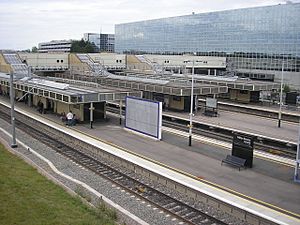
Buckinghamshire is part of the London commuter belt, so it has good train links.
Chiltern Railways runs most local commuter services from the center and south of the county to London. Great Western operates services from the very south to London. West Midlands Trains and Southern provide services from Milton Keynes Central.
Avanti West Coast runs inter-city trains from Milton Keynes Central to London, the North West, West Midlands, Scotland, and North Wales.
There are four main railway lines:
- The West Coast Main Line in the north, serving Milton Keynes.
- The London to Aylesbury Line, serving Aylesbury and nearby towns.
- The Chiltern Main Line, serving towns along the M40 motorway.
- The Great Western Main Line, which passes through the south of the county.
Other lines include the Marston Vale Line and the Metropolitan line of the London Underground to Amersham and Chesham. The new Elizabeth line also serves Iver.
Work is ongoing to reopen the railway route between Oxford and Bletchley. The new High Speed 2 railway is also being built to run through the county.
Towns and Villages
| Built-up area | Population (2011) | Local Authority | Notes |
|---|---|---|---|
| Milton Keynes | 229,941 | City of Milton Keynes | This area includes the planned city of Milton Keynes and nearby towns like Newport Pagnell and Woburn Sands. |
| High Wycombe | 133,204 | Buckinghamshire | Includes suburbs like Downley and Hazlemere. |
| Aylesbury | 74,748 | Buckinghamshire | This is the county town of Buckinghamshire. Its population includes nearby villages. |
| Amersham/Chesham | 46,122 | Buckinghamshire | This area combines both Amersham and Chesham. |
| Gerrards Cross | 20,633 | Buckinghamshire | Includes Chalfont St Peter. This is the fifth largest urban area in the county. |
| Marlow | 18,261 | Buckinghamshire | |
| Beaconsfield | 13,797 | Buckinghamshire | |
| Buckingham | 12,890 | Buckinghamshire | This was historically the county town. |
| Princes Risborough | 8,231 | Buckinghamshire | |
| Wendover | 7,702 | Buckinghamshire | |
| Olney | 6,477 | City of Milton Keynes | |
| Chalfont St Giles | 7,957 | Buckinghamshire | Includes Seer Green and Jordans. |
| Prestwood | 7,501 | Buckinghamshire | Includes Great Missenden. |
| Winslow | 4,407 | Buckinghamshire |
For a complete list of all towns, villages, and small settlements in Buckinghamshire, you can check the List of places in Buckinghamshire.
Education in Buckinghamshire
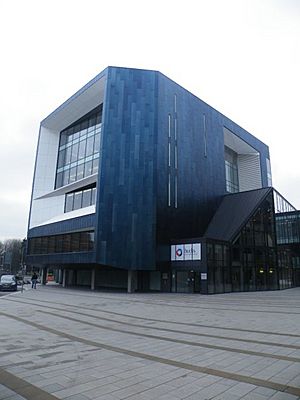
In the 1850s, artist Harriet Anne Smart Callow started a school in Buckinghamshire. She taught local workers how to read. Today, education in Buckinghamshire is managed by two local authorities: Buckinghamshire Council and Milton Keynes City Council.
Buckinghamshire Council still uses a selective education system. This means students take an exam called the Eleven-Plus exam. Based on their results and preferences, they go to either a grammar school or a secondary modern school (or a free school). If students don't take the test, they can only go to secondary modern schools or free schools.
Milton Keynes City Council uses a different system called comprehensive education. This means students go to a local secondary school without needing to take an exam.
Buckinghamshire is also home to several universities: the University of Buckingham, Buckinghamshire New University, the National Film and Television School, and the Open University. The University of Bedfordshire also has a campus in Milton Keynes.
Famous People from Buckinghamshire
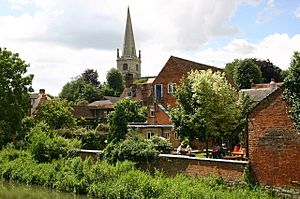
Many famous people were born or lived in Buckinghamshire.
In early history, Saint Osyth was born in Quarrendon and buried in Aylesbury. Saint Rumbold was buried in Buckingham. Later, Edward the Confessor had a palace in Brill.
Buckinghamshire has been home to many famous writers. John Milton lived in Chalfont St Giles, and you can still visit his cottage. Mary Shelley and Percy Bysshe Shelley lived in Marlow. Later authors include Jerome K. Jerome, T. S. Eliot, Roald Dahl (who lived in Great Missenden), and Enid Blyton. Modern writers from Bucks include Terry Pratchett and Tim Rice.
During World War II, some European leaders in exile lived in Buckinghamshire because it was close to London. For example, President Edvard Beneš of Czechoslovakia lived in Aston Abbotts.
Many important political figures have also lived here. These include Nancy Astor at Cliveden, and former Prime Ministers Benjamin Disraeli and Archibald Primrose, 5th Earl of Rosebery. The current Prime Minister of the United Kingdom has an official country home at Chequers.
Other notable people from Buckinghamshire include:
- Amber Bain, a musician.
- James Corden, an actor, grew up in Hazlemere.
- Jack Garratt, a singer-songwriter.
- Howard Jones, a musician.
- Prince Michael of Kent, a member of the British Royal Family, was born in Iver.
- Leigh-Anne Pinnock, a singer from Little Mix.
- Steve Redgrave, a famous Olympic rower.
- George Gilbert Scott, a well-known architect.
- Michael York, an actor.
Many celebrities also live in Buckinghamshire, such as:
- Fern Britton, a television presenter.
- Barry Gibb, a musician from the Bee Gees.
- Sir David Jason, an actor.
- Peter Jones, a businessman.
- Jason "Jay" Kay, the frontman of Jamiroquai.
- Ozzy Osbourne, a musician.
- Liam Payne, a member of One Direction.
- Jackie Stewart, a three-time Formula One champion.
- The Rothschild family, famous bankers, had many houses here.
See also
 In Spanish: Buckinghamshire para niños
In Spanish: Buckinghamshire para niños



